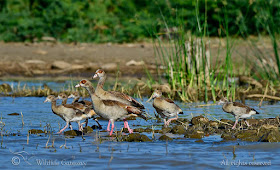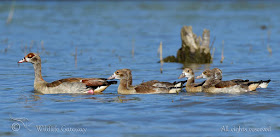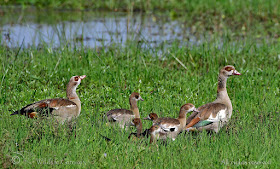Bien que commune en Europe à présent l'espèce, essentiellement sédentaire, est originaire d'Afrique sub-Saharienne ainsi que de la vallée du Nil jusqu'à Assouan où elle reste principalement autour des points d'eau et des zones inondées. Elle présente une grande variation dans la teinte du plumage qui varie du gris au brun.
Dans l'Égypte antique, cet oiseau était considéré comme sacré.
Les plus proches parents de cette oie sont les tadornes.
Egyptian goose
Quite common now in Europe, the species originates from southern Africa and remains mostly around open waters. The plumage varies from grey to brown. In ancient Egypt the bird was considered sacred. Their closest relatives are the shelducks.
Sorry dear friends, I am again quite busy preparing my next trip and a few posts for you to enjoy while I'm away.
Again, I will have no connection whatsoever...
Enjoy your outings and obs, may they be very successful!
All the best and "see" you again from mid May on.
Désolée de ne pas passer autant que je voudrais chez vous mais je me prépare à repartir vers le grand sud africain dans quelques jours et cette fois encore, pas de connexion avec Internet.
Je vous souhaite du beau temps et de bien profiter de vos observations et sorties!
Mes amitiés à tous et à toutes :)













Coucou Noushka,
RépondreSupprimerElles sont vraiment superbes ces Ouettes, toutes les photos sont superbes, mais alors la dernière ou on distingue toutes les couleurs avec l'aile déployée, c'est simplement magique !
Bises et bonne soirée à toi
Ils sont adorables ces ados !!! Ce sont de très belles oies, je ne me lasse pas de les observer en Afrique. Ici je trouve qu'il leur manque quelque chose.
RépondreSupprimerBises chez toi et bonne soirée.
Magníficas fotos de esta preciosa anátida.
RépondreSupprimerSaludos
Geese are beautiful and their photos are great. I wish you wonderful observations during your stay in South Africa. Regards.
RépondreSupprimerLovely photos and I love the in flight shots. Enjoy your trip, I will be with you in mind if not in body. Big hugs Diane
RépondreSupprimerHi Noushka.
RépondreSupprimerBeautiful Goose.
Nice the little ones there.
Beautiful pictures
Groettie from Patricia.
on en voit aussi en Moselle ! superbes bravo Noushka ...on se régalera de tes photos à ton retour
RépondreSupprimerCoucou Noushka, encore des photos qui me font rêver. Quelles couleurs et sur la dernière c'est de toute beauté. J'adore voir les jeunes à la queue leu leu, les envols. Sur la deuxième le piqué est si parfait que l'on voit tout les dessins du plumage de son bidou et celle d'après avec les ailes déployées en offrande, tout cela est magique.
RépondreSupprimerBon début de semaine et plein de gros bisous
chatou
This species is also being observed in many cities in North America. Beautiful photographs, Noushka! I like the family portraits.
RépondreSupprimerEnjoy your trip!
Hi Noushka,
RépondreSupprimerWonderful set of images of the Egyptian Goose, a bird we have in reasonable numbers at Rutland Water.
They tend to be a bit of a nuisance with the Ospreys, the older more experienced males stand for no trouble with them.
Two years ago a pair of young first time in breeding birds had the nest and the one and only egg destroyed by these geese.
All the best, John
Lovely pictures. I always thought they looked like a cross between a goose and a duck!
RépondreSupprimerYnanks Nick, indeed several species look like a cross between a goose and a duck!!!
Supprimerc'est surtout sur ta dernière photo de l'oiseau en vol que l'on voit parfaitement toutes les belles couleurs de cet oiseau !
RépondreSupprimerje te souhaite un bon voyage , tu vas encore nous rapporter de superbes photos, Profite bien
bises et à bientot
Hi Noushka. Was on Osprey duty at Rutland Water yesterday and had quite a long conversation with some visitors about Egyptian Geese. They are spreading rapidly and are a real nuisance, particularly as they seem to be the ealiest water birds to breed. I have mixed feelings about their appearance too - much of their plumage is magnificent, as your super images show, but I find the head to be most unattractive.
RépondreSupprimerI hope that all is well with you. Take good care - - - - Richard
That should have been 'earliest' water birds to breed!
SupprimerHi Noushka,
RépondreSupprimerEgyptian goose are very common in the Netherlands. Once they escaped and gained their freedom it appeared that they were very well able to survive in the wild. They can be quite agressive to other birds. Besides that you can consider them as guards, warning other animals when human beings or animals are getting too close.
The black-winged kite sometimes shows up with us, like a couple of days ago. I have seen one once during the wintertime.
Gazelles are very elegant. It is a pleasure to see them running. Travelling through Africa you can see impala's very often, in a way getting used to them. The other kinds of gazelle's I have not seen as often as impala's.
Anyway, I liked the pictures giving me a flashback of some trips I made in the past.
Greetings, Kees
Dearest Noushka,
RépondreSupprimerWow, that last photo shows the beautiful green in the wings of the Egyptian goose; most stunning water fowl.
Sending you hugs,
Mariette